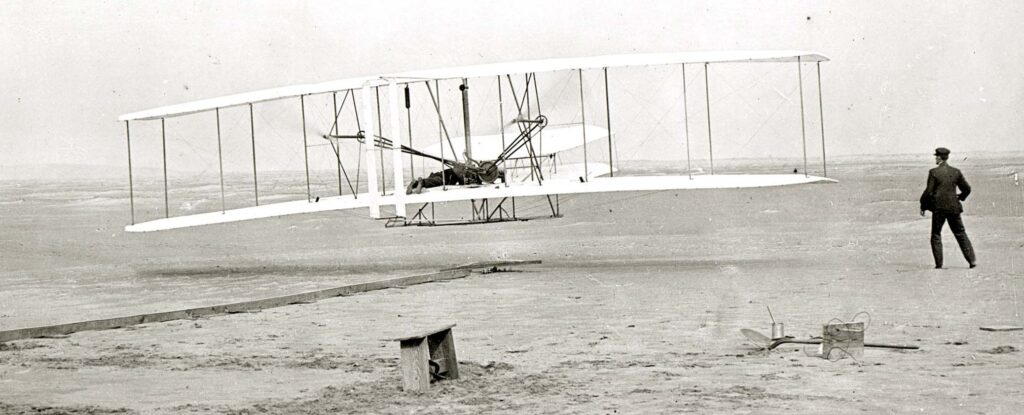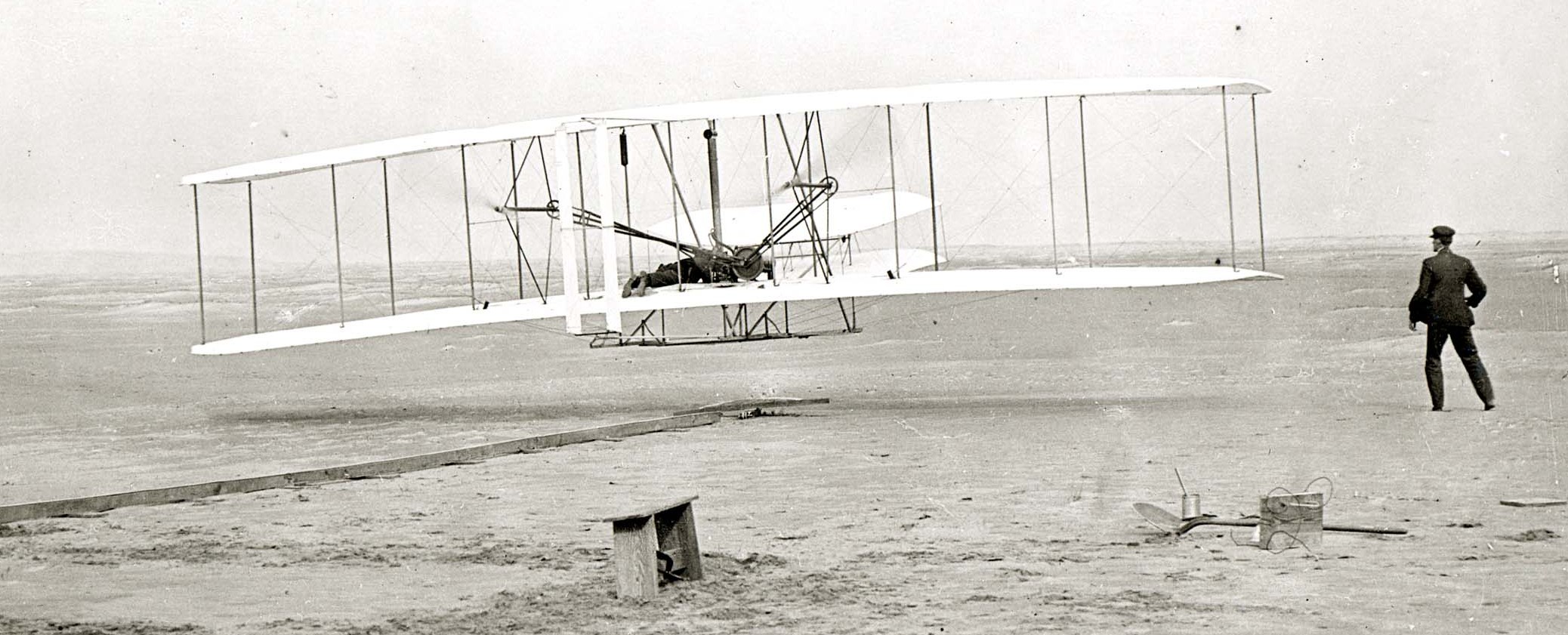
The Wright Brothers’ First Flight: A Pivotal Moment in Aviation History
On December 17, 1903, near Kitty Hawk, North Carolina, Wilbur and Orville Wright achieved what many considered impossible: sustained, controlled, powered flight. The Wright brothers’ first flight marked not just a personal triumph for the siblings, but a transformative moment in human history, ushering in the age of aviation. This event, meticulously planned and executed, stands as a testament to their dedication, ingenuity, and perseverance.
The Road to Kitty Hawk: A Journey of Innovation
The Wright brothers, bicycle mechanics from Dayton, Ohio, became fascinated with flight after reading about Otto Lilienthal’s glider experiments in the late 1890s. Unlike many who were primarily focused on power, the Wrights believed that control was the key to successful flight. They systematically studied aerodynamics and developed innovative methods to control their aircraft, including wing warping, a technique to control roll, and a movable rudder for yaw.
Their methodical approach involved building and testing a series of gliders. From 1900 to 1902, they conducted extensive experiments at Kitty Hawk, a location chosen for its consistent winds and soft sandy ground, ideal for landing. Each year, they refined their designs based on observations and data collected from their flights. [See also: The Evolution of Airplane Wing Design]
Challenges and Setbacks
The path to the Wright brothers’ first flight was fraught with challenges. They faced skepticism from the public and the scientific community, as well as technical hurdles in designing an engine light and powerful enough for sustained flight. Existing aeronautical data proved unreliable, forcing them to develop their own tables and formulas. They even built their own wind tunnel to accurately test different wing shapes.
One significant obstacle was the design of propellers. Existing marine propeller theory proved inadequate for aircraft, so the Wrights treated the propellers as rotating wings, applying their aerodynamic knowledge to create efficient air screws. This innovative approach was critical to their success. Their dedication to solving these problems is a key factor in understanding how the Wright brothers’ first flight came to be.
December 17, 1903: The Day History Took Flight
The morning of December 17th was cold and windy. After several days of delays due to unfavorable weather, the Wrights decided to proceed with their flight attempts. They tossed a coin to determine who would go first. Wilbur won the toss, but his first attempt resulted in a stall and a minor crash.
Orville took the controls next. At 10:35 AM, the Wright Flyer, also known as the Flyer I, lifted off the ground. The aircraft flew for 12 seconds and covered a distance of 120 feet. This brief but historic flight proved that sustained, controlled, powered flight was indeed possible. The Wright brothers’ first flight was a reality.
Subsequent Flights and Improvements
Following Orville’s successful flight, Wilbur and Orville each made two more flights that day. The fourth and final flight, piloted by Wilbur, covered a distance of 852 feet in 59 seconds. These flights demonstrated the increasing control and stability of the Wright Flyer. [See also: Early Aviation Pioneers and Their Contributions]
Although the Wright Flyer was damaged later that day by a gust of wind, the Wright brothers had achieved their goal. They telegraphed their father, informing him of their success. The news, however, was initially met with skepticism and misreporting by the press. It took several years for the significance of the Wright brothers’ first flight to be fully recognized.
The Significance of the Wright Brothers’ Achievement
The Wright brothers’ first flight revolutionized transportation and warfare. It paved the way for the development of commercial aviation, connecting people and cultures across vast distances. It also transformed military strategy, introducing aerial reconnaissance and combat.
Beyond the practical applications, the Wright brothers’ first flight symbolized human ingenuity and the power of perseverance. Their story serves as an inspiration to engineers, scientists, and dreamers around the world. It highlights the importance of systematic experimentation, data-driven decision-making, and the courage to challenge conventional wisdom. [See also: The Impact of Aviation on Modern Society]
A Legacy of Innovation
The Wright brothers continued to refine their aircraft and develop new technologies. They established the Wright Company in 1909 to manufacture and sell airplanes. Their inventions and innovations had a profound impact on the development of aviation, shaping the design of aircraft for decades to come.
The Wright Flyer is now displayed at the National Air and Space Museum in Washington, D.C., a testament to the Wright brothers’ first flight and their enduring legacy. Their achievement remains one of the most significant milestones in human history, a reminder that even the most audacious dreams can be realized through dedication, innovation, and a relentless pursuit of knowledge.
Analyzing the Wright Brothers’ Success
Several key factors contributed to the success of the Wright brothers’ first flight. First, their focus on control, rather than simply power, was crucial. They understood that a stable and controllable aircraft was essential for sustained flight. Second, their systematic approach to experimentation allowed them to identify and address technical challenges effectively. Third, their willingness to challenge existing theories and develop their own solutions, such as the design of propellers, set them apart from other inventors of their time.
Furthermore, their collaborative partnership was essential. Wilbur and Orville worked closely together, complementing each other’s strengths and compensating for each other’s weaknesses. They shared a common vision and a unwavering commitment to achieving their goal.
The Lasting Impact of Flight
The Wright brothers’ first flight not only changed the world but also inspired countless others to pursue their dreams. The legacy of the Wright brothers continues to inspire innovation and exploration in aviation and beyond. Their story is a powerful reminder that even the most ambitious goals can be achieved through hard work, dedication, and a relentless pursuit of knowledge.
In conclusion, the Wright brothers’ first flight on December 17, 1903, was a watershed moment in history. Their achievement transformed transportation, warfare, and our understanding of what is possible. The dedication and ingenuity that led to that pivotal moment continue to inspire generations. The impact of the Wright brothers’ first flight resonates even today, shaping the world we live in.

